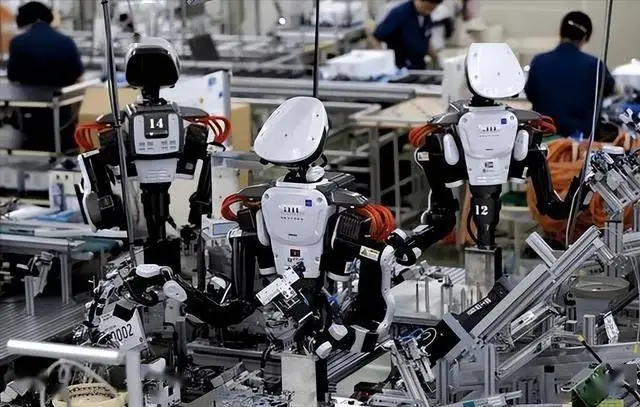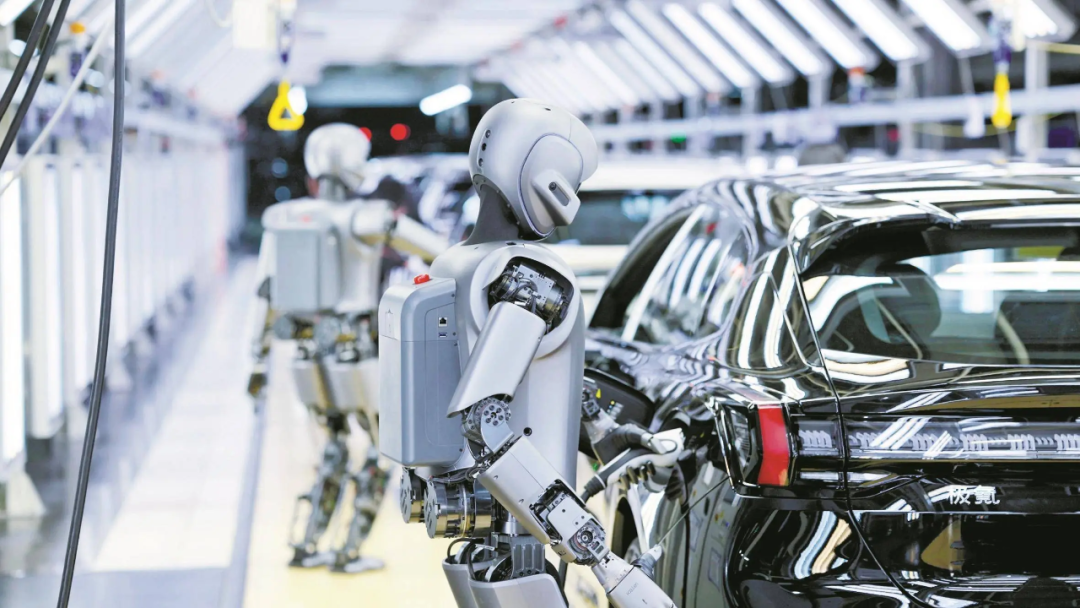From Widespread Use to Unmatched Capability: The Ascent of China's Robots
![]() 11/17 2025
11/17 2025
![]() 541
541

Taking Center Stage at the National Games, CIIE, and Internet Conferences
Original Content by Youdianshu Digital Economy Studio
Author | Uncle You
At the recently concluded National Games, robots not only performed Lingnan music by striking bronze instruments but also took part in the 100-meter torch relay. During the Internet Conference in Wuzhen, robots engaged in combat on stage and also skillfully brewed a cup of coffee. At the CIIE in Shanghai, robots enhanced the accuracy of production line inspections and became warm companions in the home. At these recent large-scale events, Chinese-made humanoid robots have evolved from being widely present to demonstrating remarkable versatility. Meanwhile, with an increasing share in exports, Chinese robots are gradually securing a leading edge in global competition.
Robots Everywhere
In Guangzhou, during the opening ceremony of the 15th National Games, bronze Juediao (replicas) dating back over two thousand years were struck once again, this time by modern robots. The rendition of 'Colorful Clouds Chasing the Moon' resonated, creating a dreamy dialogue between ancient and modern times.
In Shenzhen, robots also played a role in the torch relay. On November 2, a special 'Torchbearer 0'—the humanoid robot 'Kuafu'—made an appearance at the Shenzhen torch relay for the 15th National Games. As the world's first 5G-A humanoid robot torchbearer, 'Kuafu' completed the 100-meter relay with a highly human-like running posture under a 1.6KG single-arm load, marking a major highlight of technological innovation at the National Games.

In Wuzhen, the 'Light of the Internet' Expo at the World Internet Conference featured an interactive experience zone where visitors could immerse themselves in the endless possibilities robots bring to digital and intelligent living. They could interact with bionic robots in real-time, watch combat robots engage in duels, or witness music robots playing instruments with agility. They could even observe mechanical arms precisely brewing coffee and handling objects with finesse.
In Shanghai, the CIIE showcased the world's top robotic technologies and applications, with various robots competing and displaying their skills. A humanoid robot debuted at the expo, designed for industrial applications and capable of defect detection. During automotive manufacturing, this robot could use its right hand to hold a sensor, scan products, and analyze the data simultaneously.
Another robot, a proactive home companion, could act as a smart partner, actively seeking out users for communication. Upon arriving home and opening the door, it would run over and engage in conversation. Or, if you watched TV for too long, it would remind you to stand up and stretch. Through visual and LiDAR sensors, the companion robot could observe the home environment and user posture, promptly calling emergency contacts in case of sudden falls.
In Shenyang, the 2025 Global Industrial Internet Conference held in early September utilized interactive methods like large models, AR/VR, and intelligent products such as embodied intelligent robots to showcase cutting-edge technologies and equipment applications in the industrial sector. For instance, a newly released humanoid robot with multimodal interaction capabilities, upon receiving the command 'Get me a glass of water,' accurately located the water dispenser and cup through visual recognition, autonomously planned its path, and used its dual arms to complete the series of actions, ultimately delivering the glass of water steadily to the viewer. The entire process was smooth and stable, demonstrating its high-precision positioning and intelligent decision-making capabilities.
Multiple Factors Driving the Industry's Rise
Chinese robots have not only taken center stage at these domestic large-scale exhibitions but have also made their way into various corners of the world. In a hotel corridor in South Korea, a delivery robot sidled up, stopped steadily, popped open its hatch, and handed toothbrushes and mineral water to guests. In a family apartment in Vietnam in the afternoon, a sweeping robot finished vacuuming up the last coffee bean, turned into the bathroom by itself, and washed its mop. At an airport in Saudi Arabia, an Arabic-speaking robot pointed the way for lost travelers heading to Palm Island.
Wang Xingxing, founder of Unitree Technology, which sent robots to perform the Yangko dance on CCTV Spring Festival Gala, stated that China's industrial robot export growth rate exceeded 51% this year. He believes the intelligent robot industry should see an average growth rate of 100% this year.
Starting from the Yangko dance on the Spring Festival Gala early this year, the rapid development of Chinese robots in 2025 has exceeded many people's expectations. It can be said that this is a systemic industrial transition that combines favorable timing, geographical advantages, and human harmony.
Robots represent high-end manufacturing, and China's solid manufacturing foundation, coupled with a complete and efficient industrial chain, provides a prerequisite for the rapid development of the robot industry. Take Shenzhen, which has formed a robot industry cluster, as an example. By the end of 2024, Shenzhen had gathered 34 listed robot companies, accounting for half of the national total, driving over 70,000 upstream and downstream enterprises, with the industrial chain's total output value exceeding 200 billion yuan.

With such industrial agglomeration, in Shenzhen, the entire process from reducers, servo motors to controllers and complete machines does not exceed 30 kilometers. You can modify drawings in the morning, create prototypes in the afternoon, update firmware at night, and have it running at the client's site the next morning. This rapid iteration speed significantly shortens the cycle from research and development to market.
From performing the Yangko dance to entering factories, we can sense continuous breakthroughs in robotic technological innovation, with increasingly prominent cost-effectiveness advantages. Data shows that China holds over 200,000 valid robot patents, accounting for about one-third of the global total. These patents have extensively covered core component levels, forming a technologically reservable pool for mass production and cost reduction. For example, under the same torque conditions, the price of domestically produced harmonic reducers is only half that of foreign companies, with the delivery cycle shortened from 8 weeks to 2 weeks.
Industrial development cannot be separated from capital support. In 2025, the concept of embodied intelligence, represented by humanoid robots, rapidly heated up in the capital market. Wind data shows that from the beginning of the year to October 31, the embodied intelligence index in the secondary market rose by over 60%, and the robot index also increased by over 35%. Stocks like SWANCOR and Sanhua Intelligent Controls were sought after by funds due to their association with robot concepts, leading to a surge in their stock prices.
Behind the capitalization wave of embodied intelligence companies lies a critical period when the industry begins to move towards mass production. 2025 is regarded as the first year of mass production for the embodied intelligent robot industry. As overseas and domestic embodied intelligent robot manufacturers gradually mature in research and development design, secure orders from downstream clients, and promote mass production, the demand for funds becomes more apparent. Against the backdrop of the capital market supporting hard technology companies to go public, relevant companies plan to raise funds through IPOs to further accelerate their development.
According to statistics from Gaogong Robot Industry Research Institute, in the first half of 2025 alone, there were 144 financing events in the upstream and downstream of the embodied intelligent industry chain, with a total financing amount reaching 19.5 billion yuan, far exceeding the entire year of 2024. Numerous embodied intelligence companies are accelerating their IPOs. Over a dozen companies, including Standard Robots, Woan Robot, Ledong Robot, and SEER Robotics, have submitted listing applications to the Hong Kong Stock Exchange in droves.
From industrial agglomeration to capital pursuit, these elements collectively constitute the driving force behind the rapid development of Chinese robots. The absence of any single link would prevent this wave from reaching its current height.
Manifestation of 'Long-Term Strategic Thinking'
From the perspective of national major technological development, China has already achieved a transition from catching up to running alongside, and even surpassing, foreign countries in many fields. In the field of embodied intelligent robots, it can be said that several major global powers are at the same starting line. If the country strengthens its layout and increases investment, we have the potential to achieve leadership in this field.
According to data from the International Federation of Robotics, headquartered in Germany, China has long been the world's largest market for industrial robots, with approximately 1.8 million robots operating in factories and other industrial environments in 2023. The institution's data also shows that while Japanese and European robot manufacturers still dominate the global industrial robot market, Chinese manufacturers are rapidly rising, with their domestic market share growing to about half.
A recent report by investment bank Morgan Stanley believes that China is gaining an advantage in the robot competition, ahead of the United States. Specifically, China's rapid progress in robot research and development and manufacturing is mainly attributed to 'rare earth resource advantages, policy incentives, and educational system support.'
Morgan Stanley believes that, in addition to resource advantages, the improvement in China's domestic manufacturing processes cannot be overlooked. This improvement benefits from the combination of technology transfer from foreign companies and local technological innovation in China. Chinese companies, encouraged by the government, have formed a highly active robot research and development environment, with intense competition among enterprises. New ideas continuously replace outdated technologies. Morgan Stanley believes that this 'competition' is one of the important driving forces behind the accelerating pace of Chinese robot research and development.
Morgan Stanley emphasizes in its report that China's advantages in robot development are not only reflected in resources, policies, and education but also in 'long-term strategic thinking.' The report cites the strategic characteristics of the traditional Chinese board game 'Go,' stating that China tends to gradually lead its opponents into a disadvantageous position through 'patience and coexistence competition' to achieve ultimate victory, rather than pursuing 'short-term performance.'
Compared to international industrial competition, more importantly, for the national economy, the development of humanoid robots can significantly drive the development of upstream and downstream industrial chains such as machinery, high-end manufacturing, electronics, software, and sensors. Therefore, Chinese robots do not represent a single industry; the diversification of upstream and downstream demands provides them with a broad market space.
For example, automotive manufacturing, as a traditional application market for industrial robots, drives the demand for robots in welding, handling, painting, and other process links. In lithium battery production and manufacturing, industrial robots are applied in multiple links such as handling, loading and unloading, gluing, stacking, and assembly. Additionally, the electronics industry, as another important field for robot applications, imposes higher requirements on the speed, precision, and stability of robot operations due to rapid product updates and high production precision requirements. The special demands of different industries prompt robot companies to transition from providing general-purpose products to industry-specific solutions. This professionalization trend is becoming an important competitive strategy for domestically produced robots.

Leading Chinese robot companies will no longer be limited to product output but will transform towards comprehensive upgrades in technology, scenarios, and ecosystems. This development strategy provides a highly valuable rise sample for China's intelligent manufacturing.
THE END
This article is an original piece by Youdianshu View and cannot be reproduced in any form without permission.







